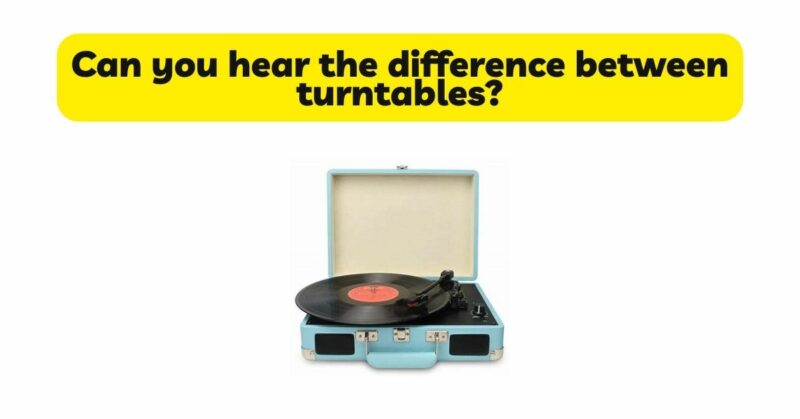Among audiophiles and music enthusiasts, a recurring debate revolves around the ability to discern sonic differences between various turntables. Some argue that the choice of turntable makes a significant impact on sound quality, while others claim that the differences are minimal and difficult to perceive. In this article, we will delve into the factors that influence sound reproduction in turntables and explore the extent to which listeners can hear the disparities between different models.
- The Role of Turntable Components
The components within a turntable play a crucial role in shaping the sound. Here are some key factors to consider:
a. Platter and Platter Material: The platter’s mass, material, and design influence its resonance characteristics and rotational stability. These factors can impact the accuracy of speed and reduce unwanted vibrations, thereby affecting sound quality.
b. Tonearm: The tonearm’s design, build quality, and materials used contribute to its tracking ability, resonant behavior, and damping characteristics. A well-designed tonearm can minimize resonance and ensure precise tracking, resulting in improved sound reproduction.
c. Cartridge and Stylus: The cartridge and stylus are responsible for converting the mechanical vibrations from the vinyl grooves into electrical signals. Different cartridges have varying frequency response, tracking ability, and tonal characteristics, which can lead to subtle variations in sound reproduction.
d. Motor and Drive System: The motor and drive system control the rotational speed and stability of the turntable. High-quality motors and drive mechanisms can minimize speed fluctuations and vibration, which can impact the accuracy and consistency of sound reproduction.
- Turntable Build Quality and Construction
The build quality and construction of a turntable can affect its sonic performance. A well-constructed turntable with sturdy materials and precise engineering can minimize resonances, vibrations, and unwanted noise. On the other hand, a poorly built turntable may introduce unwanted artifacts that can degrade the sound quality.
- Analog Sound Characteristics
Turntables are often associated with certain analog sound characteristics that differentiate them from digital formats. These characteristics include:
a. Warmth and Richness: Analog sound reproduction can impart a warmth and richness to the music. The continuous waveform of analog audio can provide a smooth and organic sound that some listeners find appealing.
b. Dynamic Range: Vinyl records have the potential to offer a wider dynamic range compared to some digital formats. This ability allows for the faithful reproduction of the original recording’s dynamics, enhancing the impact and realism of the music.
c. Sound Coloration: Vinyl records have their own unique sound coloration, influenced by factors such as surface noise, pops, and crackles. While some may perceive these imperfections as flaws, others argue that they add character and a sense of nostalgia to the music, creating a more authentic listening experience.
- Listener Sensitivity and Perception
The ability to hear differences between turntables can vary among individuals. Factors such as listener sensitivity, experience, familiarity with different sound signatures, and the listening environment all contribute to the perception of sound quality. Some listeners may have trained ears and keen attention to detail, enabling them to discern subtle nuances, while others may have a more casual listening approach and find it challenging to distinguish between different turntables.
- Source Material and Recording Quality
The quality of the source material, particularly the vinyl records, greatly impacts sound reproduction. Vinyl records can vary in terms of mastering quality, pressing quality, and condition. Well-mastered and properly pressed records will showcase the full potential of a turntable’s capabilities, whereas poorly produced or damaged records may limit the discernible differences between turntables.
- Testing and Comparison Methods
When conducting comparisons between turntables, it is crucial to employ rigorous testing methods and control variables. A/B testing with the same source material, listening in a controlled acoustic environment, and utilizing high-quality audio equipment can aid in making accurate judgments about sound differences.
Conclusion
The question of whether listeners can hear the differences between turntables is subjective and multifaceted. While the components, build quality, and analog sound characteristics of turntables contribute to potential variations in sound reproduction, individual listener sensitivity, experience, and the quality of the source material also play significant roles. It is important to acknowledge that not all listeners may perceive or appreciate subtle differences, and personal preferences ultimately guide one’s choice of turntable. For enthusiasts who value the unique characteristics of turntables and seek to optimize sound quality, careful consideration of turntable components, build quality, and source material can lead to a more rewarding listening experience.


